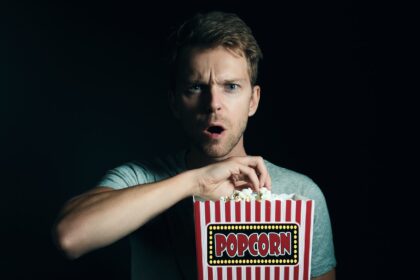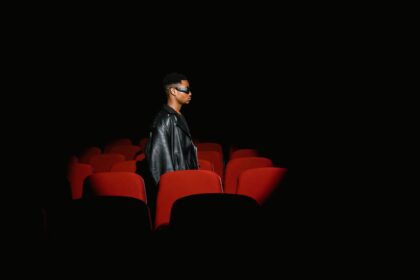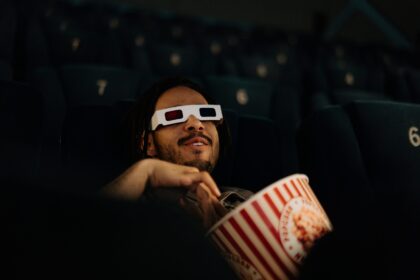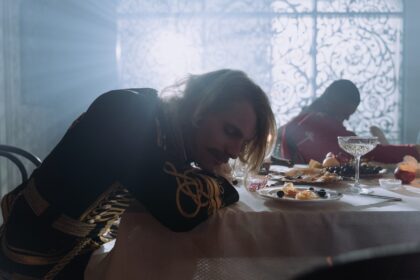Lucid Dreaming in Motion: Exploring Animated Films
Where dreams become animated masterpieces, and reality gets a wild makeover, we find films that aren’t just visually stunning – they’re invitations to play with the fabric of reality itself. Think of it as lucid dreaming with a side of popcorn and an extra-large dose of whimsy.
From the mind-bending landscapes of “Paprika” to the philosophical musings of “Waking Life,” these films blur the lines between waking and dreaming. Expect the unexpected, question your assumptions, and see the world through a kaleidoscope of dreams.
Scanner Darkly (2006)
Welcome to the trippy, pulsating world of Richard Linklater’s ‘A Scanner Darkly,’ an animated wonder flirting with the concept of lucid dreaming without making it the central theme. This unique cinematic experience, featuring Bob Arctor (Keanu Reeves) as an undercover cop entangled in the gnarly web of drug addiction and surveillance, skillfully blurs the lines of reality, identity, and perception.
While diving into Arctor’s subconscious, the audience is introduced to his lucid dreams, where he indulges in aerial flights of fantasy and poignant chit-chats with his deceased father. These dreamscapes allow Arctor a sandbox for self-exploration and a rendezvous with his mortality. As a cult classic, ‘A Scanner Darkly’ uses rotoscoping and elements akin to lucid dreaming to weave a reality-bending narrative worth exploring for any dream enthusiast or lover of conscious-altering cinema.
Waking Life (2001)
Let’s unspool our reel into the vividly drawn universe of ‘Waking Life,’ a cinematic gem from the imaginative mind of Richard Linklater. No ordinary animated feature, this film takes you on a psychedelic journey into the labyrinth of lucid dreaming, providing a platform to ruminate over life’s profound questions. Imagine finding yourself in an unending cycle of lucid dreams as Wiley Wiggins, our enigmatic protagonist, engages with an intriguing cast in deep philosophical discussions. The film teases your intellect, tossing you into a vortex of existential thoughts, debates on free will, and perception experiments. Sounds like an ordinary Tuesday, right? That’s quite the head trip that ‘Waking Life’ promises.
The visual elegance of ‘Waking Life’ deserves special mention, thanks to the use of rotoscoping—a process that magically morphs live-action scenes into surreal animations, making you feel as if you’ve stepped into a vibrant, pulsating painting. This artistic decision amplifies the film’s dream-like aura and seamlessly underscores the blurred line between dreams and reality. Released in 2001, ‘Waking Life’ garnered much praise for its unique animation style and cerebral, dialogue-driven narrative. In essence, the film ensures that the dream, or shall we say the enthralling spectacle, is only beginning!
Paprika (2006)
Buckle up for a ride into Satoshi Kon’s psychedelic masterpiece, ‘Paprika.’ The 2006 film doesn’t just explore lucid dreaming—it plunges you right into its vibrant core. The story follows Dr. Atsuko Chiba, aka ‘Paprika,’ a dream detective armed with the DC Mini—a device allowing therapists to visit their patients’ dreams. When this dream-traversing device is stolen, the boundaries between dreams and reality blur, and it falls upon Paprika to navigate this swirling chaos.
‘Paprika’ brilliantly crafts surreal and visually stunning dream sequences, underscoring the power of lucid dreaming as a tool for exploration and psychological therapy. Here, dreams are not merely subconscious images but dynamic landscapes consciously manipulated by the dreamer. With an impressive 7.7/10 IMDb rating and an 85% Rotten Tomatoes score, the film questions identity and perception, merging the profound with the playful. Strap in—this is a dreamland where reality and illusion are two sides of the same coin!
Where Lucid Dreams Meet Wacky Animation
While flicks like “Scanner Darkly,” “Waking Life,” and “Paprika” take you on a direct flight into the heart of lucid dreaming, other animations offer a subtler journey into the surreal. Think “Alice in Wonderland” or “Anomalisa” — these films may not scream “lucid dreaming” at first glance, but their playful explorations of reality and perception make you wonder if you’re watching with your eyes or with your mind. Cinematic dreamscapes abound, where the impossible goes grocery shopping and the line between waking and dreaming? Let’s just say it starts to resemble a melting popsicle on a hot day.
Alice in Wonderland (2010)
Dive down the rabbit hole with Tim Burton’s “Alice in Wonderland,” and you’ll find more than just a quirky tea party. In this 2010 cinematic romp, Wonderland—or as the cool kids call it, Underland—isn’t just a place for mad hatters and cheshire grins; it’s a masterclass in lucid dreaming with a side of whimsy. Mia Wasikowska’s Alice isn’t just wandering; she’s tactfully navigating a world that bends the rules of physics like a cosmic contortionist.
With every oversized mushroom and shrinking potion, Alice’s adventure mirrors the capricious nature of our own dreamscapes. Here, rabbits are not only late, but they talk, and cats disappear, leaving nothing but a grin, tickling the funny bone of reality itself. Alice’s knack for questioning this zany reality echoes a lucid dreamer’s reality check. This film serves a feast for the eyes with its lush, fantastical landscapes and winks at the intriguing complexities of lucid dreaming, where everything, even the impossible, is up for grabs. So, don your best hat, grab a cup of tea, and let Alice guide you through a course in Dreaming 101, Burton style.
Mind Game (2004)
“Mind Game” serves as director Masaaki Yuasa’s playground where reality isn’t just bent—it’s put through the wringer. This anime isn’t merely a visual spectacle; it’s an exploration of the mind’s limitlessness. The story follows Nishi, a budding comic artist whose near-death misadventure launches him into a kaleidoscopic journey of bizarre encounters and introspective quests that might make even the most seasoned surrealists double-take.
As Nishi navigates through a tapestry of celestial oddities and earthbound absurdities, “Mind Game” morphs into a dream-like canvas where rules are as fluid as the animation itself. The shifting realities and oddball logic resonate deeply with the anything-goes nature of lucid dreaming, where the mind runs wild with possibilities. Whether Yuasa consciously drew from lucid dreaming or not, his creation invites viewers to question their perceptions and embrace the weird, redefining the boundaries between the waking world and the fantastical realms of the subconscious.
Renaissance (2006)
Set against a backdrop of a dystopian Paris in 2054, ‘Renaissance’ redefines animation with a visually arresting dystopian thriller. This French sci-fi film dives deep into the rabbit hole of futuristic nightmares where dreams are more than just nightly entertainment; they’re a playground for the mind. The film follows a grizzled police detective unraveling the knotty disappearance of a scientist amidst a sinister mesh of corporate espionage and biotech intrigue. But it’s not just the plot that screams ‘dreamscape’; the stark, monochromatic animation style creates a hyper-real universe that might just make you question if you’re awake or still in bed.
While “Renaissance” doesn’t explicitly explore lucid dreaming, it flirts with the theme in its own cryptic way. The film toys with perception and reality, nudging viewers to ponder on what’s genuinely real versus meticulously crafted illusions—echoing the lucid dreamer’s knack for bending dream worlds to their will. With its mind-bending visuals and cerebral narrative, the movie wraps viewers in a cocoon of dream-like wonder, similar to the lucid dreamer’s journey of navigating and manipulating their nocturnal narratives. It’s a visual and thematic feast tailored for those who like their dreams served with a side of existential dread.
Coraline (2009)
The peculiar world of “Coraline” blurs the lines between whimsical daydreams and eerie nightmares with the smudged edges of a half-remembered dream. This stop-motion masterpiece isn’t just about a girl finding a secret door; it’s about discovering an alternate reality so tempting that it might make you double-check the locks on your fridge at night. Coraline’s escapades in the Other World, with its colors so vivid they could make a Skittles bag blush and oddball inhabitants, play out like a lucid dream turned inside out. Initially, this world seems like the perfect escape from her mundane life, but as the seams unravel, Coraline finds herself trapped in a world less tailor-made and more like a sweater knitted by a vengeful grandma.
As our blue-haired heroine grows wiser to the twisted fabric of this dream-like realm, the story weaves in elements that mirror the lucid dreaming experience—awareness within the dream, the power to alter its narrative, and the chilling realization of being stuck in a sinister plot. Coraline’s journey is peppered with symbols ripe for Freudian analysis, from the button-eyed doppelgängers (because who hasn’t had nightmares about their grandma secretly being a sentient pincushion?) to the ominously inviting little door, each element hinting at deeper desires and fears. While “Coraline” doesn’t spell out lucid dreaming, it stitches together a compelling narrative on the enticements and dangers of wielding control within one’s deepest fantasies. Like any seasoned lucid dreamer, Coraline learns that even in a dream, all choices have consequences, and sometimes, bravery is knowing when to wake up.
Spirited Away (2001)
“Spirited Away” whisks viewers into a labyrinth of the fantastical and the eerie, much like a vivid dream from which you don’t want to wake. In this animated masterpiece by Hayao Miyazaki, young Chihiro finds herself in a spirit world that could rival any lucid dream for its bizarre logic and shifting landscapes. Here, rivers are dragons (and they probably get grumpy if you spill tea in them), and witches run bathhouses—a world where the boundaries between the real and the unreal blur into an exquisite tapestry of adventure. The spirit world’s surreal quality, complete with strange creatures and otherworldly rules, parallels the dream-like settings that lucid dreamers navigate, where the extraordinary becomes the norm.
As Chihiro’s saga unfolds, she transitions from a lost girl to a purposeful heroine, mirroring the journey of a lucid dreamer gaining control within the dream. This narrative arc isn’t just about a girl in a strange world; it’s about mastering the chaos of that world. Chihiro’s growing realization that she can influence events around her echoes the lucid dreamer’s discovery of their power to manipulate the dream narrative. Her adventure is peppered with challenges that test her newfound abilities, from negotiating with spirits to rescuing her parents, underscoring themes of self-discovery and transformation akin to the profound personal growth often experienced in lucid dreaming.
Slumberland (2022)
“Slumberland” turns the dream world into a grand stage of adventure and wonder. Unlike your garden-variety nap, this cinematic dreamscape offers young Nemo and her rogue companion Flip the kind of vivid, fantastical experiences typically reserved for the most seasoned lucid dreamers. With settings that shift at the whim of its inhabitants and a narrative soaked in the surreal, “Slumberland” mirrors the boundless nature of dreams where anything—from flying beds to talking doorknobs with sassy attitudes—is possible.
While the film might polish the edges off the typically unpredictable lucid dream experience—favoring a more playful, consistently adventurous tone—it still captures the essence of dream manipulation and control that fascinates lucid dreamers. As Nemo maneuvers through this vividly rendered dream world, she confronts and transforms her nightmares, embodying the lucid dreamer’s potential to face fears head-on and alter their dream’s course. “Slumberland” is about mastering the art of dreaming itself, wrapped up in a visually enchanting package that might just inspire viewers to close their eyes and drift into their own nocturnal explorations.
The Nightmare Before Christmas (1993)
“The Nightmare Before Christmas” weaves a tapestry of imagination where the mundane meets the magical, offering a not-so-subtle nod to the phenomena of lucid dreaming. This Tim Burton-inspired classic doesn’t just clash worlds; it marries them in a bizarre holiday-themed fever dream that could only be choreographed in the most vivid of dreams. Halloween Town, with its gothic charm and quirky denizens, is a dreamscape that could rival any lucid dream for its sheer inventiveness and fantastical elements. Here, the protagonist Jack Skellington, with a curiosity as boundless as a child’s, discovers Christmas Town—turning what begins as a dream-like fascination into a full-blown existential quest.
Jack’s journey through these holiday realms blurs the line between dream and reality, much like a lucid dream where the dreamer recognizes they’re dreaming and begins to manipulate their surroundings. Yet, Jack’s control is imperfect, mirroring the often unpredictable nature of lucid dreaming. The film explores the power of imagination to shape environments and experiences, a core aspect of lucid dreaming, but also serves up a cautionary tale about the chaos of meddling in dreams without a full grasp of the consequences. It’s a fantastical exploration of what happens when a dreamer dives too deep, losing touch with the waking world’s boundaries but eventually finding a renewed appreciation for his own reality.
Anomalisa (2015)
“Anomalisa” emerges as a stop-motion film cloaked in existential musings and surreal interactions, creating a dream-like atmosphere that tantalizes the border of lucid dreaming. Directed by Charlie Kaufman, this cinematic piece unfurls a tapestry of perception, loneliness, and the uniquely human craving for connection. The protagonist, Michael Stone, finds himself adrift in a sea of sameness, where every face and voice blends into one monotonous hum—a reflection of the hazy, sometimes disorienting world of dreams where reality often bends and warps like a Dali painting on a hot summer day.
As Michael navigates this surreal existence, he encounters Lisa, a beacon of uniqueness in his uniform world, sparking a brief flicker of clarity akin to the lucidity in dreaming where one realizes they can exert control. This moment of connection is like a lucid dreamer seizing the reins in their dream, steering towards a desired outcome, however fleeting it might be—a cosmic “aha!” moment in a sea of confusion. “Anomalisa” explores the edges of our perception, much like lucid dreaming challenges the edges of our subconscious, blurring the lines between what’s real and what’s imagined. While it does not delve into lucid dreaming directly, the film’s exploration of a protagonist wrestling with his internal and external worlds captures the essence of navigating and manipulating one’s dream-like realities, leaving us to ponder the nature of our own consciousness and the dreams that shape it.
Fantastic Planet (1973)
Fantastic Planet” is a cinematic trip to the surreal side, where director René Laloux offers up a bizarre buffet of alien oddities and trippy landscapes that could make Salvador Dalí nod in approval. Set on the distant planet Ygam, this film invites viewers into a world where giant blue Draags treat tiny human-like Oms like disposable pets, painting a picture of oppression in wildly inventive strokes. This alien setting, with its landscapes where trees sprout eyeballs and giant snails serve as meditative gurus, crafts a dream-like vibe that mirrors the wacky unpredictability of a cheese-induced nightmare.
While “Fantastic Planet” doesn’t exactly dish out a lucid dreaming manual, it flirts with kindred themes—awareness, liberation, and tweaking reality’s nose. As the pint-sized Oms wise up to their giant overlords and start hacking their fate, the film echoes that moment in a lucid dream when you realize you can actually fly or, better yet, turn your boss into a frog. Ygam, with its mind-bending rules and transformational escapades, serves up a slice of the same introspective pie, exploring how breaking free from mental shackles can feel as liberating as realizing you’re the puppet master in your own dream theater.
Dream’s End
So, if you’re ready to leave the ordinary behind and chase a dash of the fantastical, why not revisit one of these animated gems? Embrace the wonder, let your mind take flight, and see where the dreamscape leads – you might just gain a fresh perspective on what it means to dream, both on and off the screen.




















